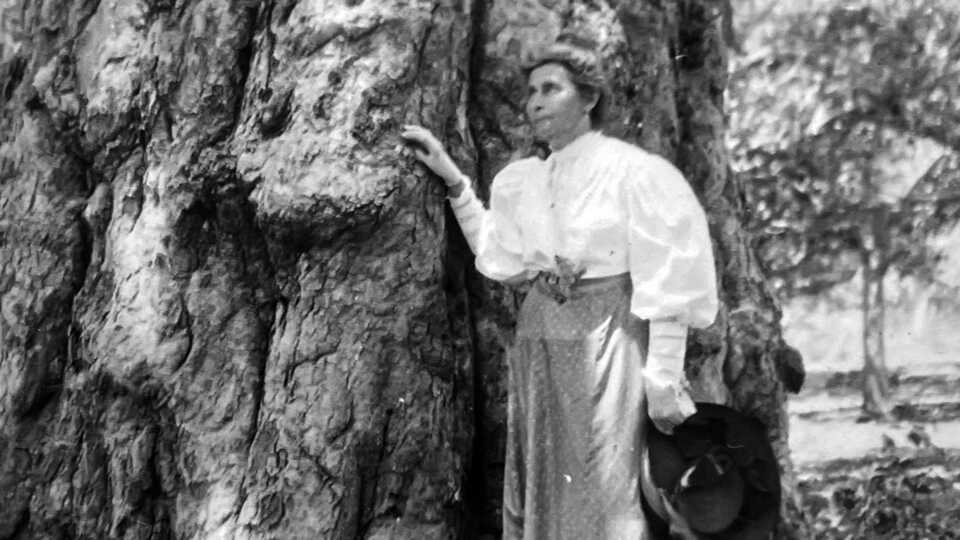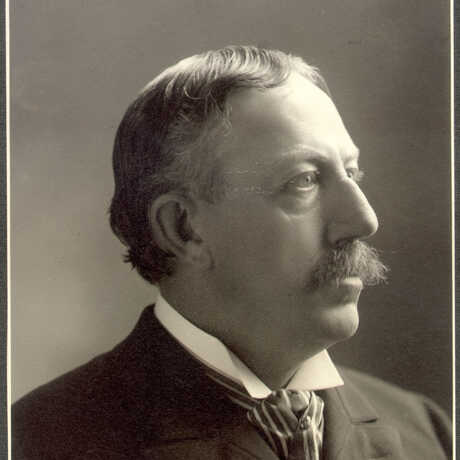Founded in 1853, the Academy Library is a research library devoted to natural history and the natural sciences. Explore our extensive collections, including rare books, serials, maps, and photography.
Untold Stories
Sara Allen Plummer Lemmon

Early life and educational background
Sara Allen Plummer Lemmon was born on September 3, 1836 in New Gloucester, Maine. At a young age, she dealt with the tragedy of her mother’s death. Therefore, she had a stronger connection with her father, whom she wrote letters to every week for thirty years while she lived in California.
Growing up as an independent woman, she was determined to receive an education. She attended teacher training at the Ladies Collegiate Institute in Worcester, Massachusetts. After moving to New York in hopes of better education, she earned a certification in physics and chemistry from Cooper Union. All the while, she financially supported herself by teaching art classes and calisthenics at a grammar school. Later, during the Civil War, Sara served as a volunteer nurse for two years at the Bellevue Hospital in New York. Unfortunately, she was a victim of frequent lung ailments due to the cold winters and she was later diagnosed with pneumonia. Therefore, she migrated to Santa Barbara, California in 1869 for a more suitable climate for her health where she discovered her interest in botany.
Life in California and marriage
Sara established the first library in Santa Barbara, and opened a stationary shop–selling stationary, art, and music supplies–inside the library as a source of income. She charged ten cents to borrow a book and $5 for a membership. She considered this business an experiment–whether it could fiscally support her or not. However, the motionless lifestyle of the business was in opposition to her lively determination for botany and adventures. Therefore, she designated a corner of her library to host intellectual meetings, where she occasionally gave lectures too. Sara was also a prolific botanical illustrator. In 1876, she, together with a few locals, founded the Santa Barbara Natural History Society where she met her future husband, John Gill Lemmon who was giving a lecture. John Lemmon was also a Civil War veteran and was imprisoned in a Confederate prison camp at Andersonville, Georgia. His imprisonment rendered him in poor health. Regardless, having many similarities, including their love for botany, they later wed.
On Thanksgiving Day, 1880 Sara married John Gill Lemmon, who was an equally passionate botanist. Their passion went to such an extent that, at the suggestion of Sara, their honeymoon was a trip to southern Arizona to study and record the native plants. Together they discovered about three percent of all Arizona’s plants. Sara was not specifically credited for discovering the new species; all published papers gave credit to “JG Lemmon and Wife.” However, her husband strongly insisted that his wife be given equal credit. During one of their trips to Arizona, she was also credited as being the first woman to climb the tallest mountain in Tucson, and the mountain was named Mount Lemmon in her honor. However, it is very plausible that an indigenous woman had climbed it first, as a native tribe resided in the proximity.
An imperfect person
Sara’s views towards indigenous people–although common at the time–were disturbing. She viewed any non-white human to be inferior. Her contempt towards indigenous people is dominant in her letters to her sister Mattie. Her views about the Apache tribe were similar. In one of her letters, she claims that she feared the Apache tribe as they were “...sly, treacherous, revengeful, cruel & love to shed the blood of the white man as much as we take pleasure in killing rattlesnakes….” On her encounter with the Hualapai tribe in Arizona, she concluded them to be the “dirtiest, sauciest, and most degraded of natives.” Her views about indigenous people were genocidal, common to her contemporaries. However, she did respect and acknowledge the Hualapai women for their hard work. Sara in general had progressive views about women’s rights and equality, and was very much engaged in politics.
Advocate for women’s equality
At the age of forty-four, she founded the Pacific Coast Women’s Press Association, in which she was a director and an auditor. The organization focused on developing plans to improve common public struggles. In addition, she took part in California Press Women and Women's Chrisitan Temperance Union. As a strong advocate for women's equality, she also strived for women's suffrage. Besides women rights, she and her husband were both abolitionists and against the secession of the Confederate south. Always encouraging women's literacy, she became one of the first seven women to be members of the California Academy of Sciences (CAS) in San Francisco. Besides women rights, she established two chapters of the American Red Cross in Oakland and San Francisco.
One of the first women members of the Academy
The minutes of the November 19,1877 member meeting included the proposal to make Sara and another woman the first female members of CAS. On January 21, 1878 Sara and six other women were accepted as the first seven female members of the Academy. Sara began to donate plant specimens to CAS but was not paid for this labor. Additionally, she would frequently visit CAS to work in the herbarium. Once she and John Gill were married, they moved to Oakland. On March 7, 1881 Sara was the first woman allowed to present a paper at CAS. Her paper addressed the morphology, geography, and ecology of the Pacific ferns. She stated, in a letter to her family, “I have the honor to be the first lady who has ever addressed that august body.” In addition to botany, she was also a magnificent artist. She was the official illustrator for the California State Board of Forestry for several years. She also donated at least twenty-five of her botanical paintings to CAS which were unfortunately lost to the earthquake and fire of 1906.
Naming the California state flower
She also immensely contributed to the naming of the golden poppy as California’s state flower. Despite her ten years of effort on this behalf, many people do not know of Sara’s contributions. Sara was chosen to be the chairman of the new California State Floral Society as the debate for a state flower surfaced. They all argued for the golden poppy to be California’s state flower. On the third introduction of the bill, the California Legislature passed; it was signed in 1903 by then Governor George C. Pardee, officially making it the state flower. Additionally, she had many plant species named after her such as Allium plummerae.
John Gill Lemmon’s passing and later life
Sara’s view of death was uncommon. She considered death to be an inevitable destination and, therefore, did not stress about it. Instead, she suggested “...keeping cheerful with a lively interest in the world.” However, the death of her husband in 1908 was difficult for her and she never made a complete recovery. She wrote “I am glad that I can look back and half realize that I’ve had the privilege of walking and working beside such a nature-nobleman for 28 years. For that I’m comforted, but for that I feel the loss inexpressibly.” She decided to continue her interest in botany but her health continued to decline. After showing significant symptoms of senile dementia , she was admitted into a state hospital in 1916. She remained in the hospital for the next six years–the rest of her life. Sara passed away on January 15,1923, at the age of 86.
Lemmon’s legacy
Sara was a passionate woman in the field of botany at a time when few women were able to get education due to the repressive system they faced. Even though her status as white undoubtedly earned her privileges, it was still uncommon for women to pursue educational goals and have careers in the sciences. Although her views of indigenous people and non-whites were genocidal and are unacceptable in today’s society, it is important to consider that many held similar views. This does not in any way justify her ideas but helps us expand our perspective of Sara instead of limiting her to a single characteristic, and instead shows that she was a complex person. For instance, despite her genocidal views, she was an activist looking out for women and her community by establishing non-profit organizations, such as chapters of the American Red Cross. Therefore, Sara was mainly a generous, determined, adventurous, and independent woman who did not hesitate to speak her mind. Her grave, beside her husband, is located at the Mountain View Cemetery in Oakland. Their gravestone, along with an engraving of a poppy, reads “partners in botany.”
References
Brown, Wynne. Forgotten Botanist: Sara Plummer Lemmon's Life of Science and Art. University of Nebraska Press, 2021.
“Sara Plummer Lemmon.” History of American Women, 31 May 2020, https://www.womenhistoryblog.com/2016/12/sara-plummer-lemmon.html.
“Sara Plummer Lemmon.” Wikipedia, Wikimedia Foundation, 22 Nov. 2022, https://en.wikipedia.org/wiki/Sara_Plummer_Lemmon#Death.
“Sara Allen (Plummer) Lemmon.” WikiTree, 5 Sep. 2022, https://www.wikitree.com/wiki/Plummer-2805#_note-1.
Guldimann, Suzanne. “Sara Plummer Lemmon: Remembering the Forgotten Botanist.” Topanga New Times, Design Like It Matters, Inc., 1 July 2022, https://topanganewtimes.com/2022/07/01/sara-plummer-lemmon-remembering-the-forgotten-botanist%ef%bf%bc/.
Sara Allen Plummer Lemmon papers, University and Jepson Herbaria Archives, University of California, Berkeley, Berkeley, CA
About the author
Moez Rehman is a Careers in Science Level 3 intern at the California Academy of Sciences.
Academy Library and Archives
California Academy of Sciences
55 Music Concourse Drive
San Francisco, CA 94118


